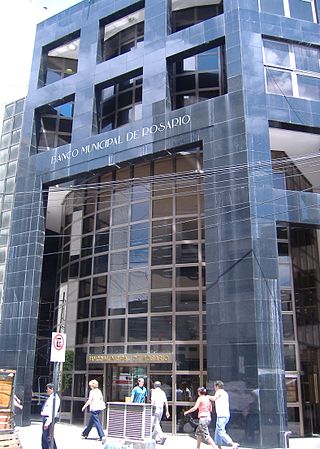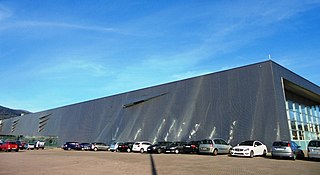
The May 1 Municipal Theater is the premier stage theater and concert hall in Santa Fe, Argentina.

The May 1 Municipal Theater is the premier stage theater and concert hall in Santa Fe, Argentina.
The theatre arose from an initiative by Mayor Sixto Sandaza, who sought to remedy the growing city's lack of a formal concert hall or architecturally significant theater. The city is the capital of Santa Fe Province, was home to 35,000 inhabitants by the 1895 Census, and had doubled in population in merely a decade. [1] The municipality commissioned French Argentine architect Augusto Plou to design the new institution, whose construction began in 1903. [2]
Plou's design for a French Neoclassical exterior and interiors in the style of Louis XV resulted from the day's architectural tastes among Argentine high society and government planners, alike. The façade was crowned with sculptures by local artist Nicolás Gulli, representing allegories of music and dance. [2]
The ornate theater was inaugurated on October 5, 1905. The institution's main hall, the Sala Mayor, seats an audience of 850, was decorated by painter Nazareno Orlandi, and is notable also for a spiderweb chandelier transferred from the city's colonial cabildo. [3]
An extensive modernization was completed in 1973, including the installation of electronic stagecraft and lighting equipment, as well as central air conditioning. Two secondary halls were also opened at the time: the Leopoldo Marechal Salon, which seats 250, and the smaller Juan Franze Salon, which hosts ballet recitals. [3]
On the occasion of the theater's upcoming centennial, Mayor Ezequiel Balbarrey commissioned its refurbishment, including the removal of the modern veranda (a visual obstacle on the façade). [2] Inaugurated on May 25, 2005, the theater's restoration was awarded a second-place prize in the subsequent Ibero-American Cultural Patrimony Restoration Contest. [4]

The Teatro Colón is a historic opera house in Buenos Aires, Argentina. It is considered one of the ten best opera houses in the world by National Geographic. According to a survey carried out by the acoustics expert Leo Beranek among leading international opera and orchestra directors, the Teatro Colón has the room with the best acoustics for opera and the second best for concerts in the world.

An opera house is a theater building used for performances of opera. Like many theaters, it usually includes a stage, an orchestra pit, audience seating, backstage facilities for costumes and building sets, as well as offices for the institution's administration.

La Plata is the capital city of Buenos Aires Province, Argentina. According to the 2022 census, the Partido has a population of 772,618 and its metropolitan area, the Greater La Plata, has 938,287 inhabitants. It is located 9 kilometers inland from the southern shore of the Río de la Plata estuary.

Rosario is the largest city in the central Argentine province of Santa Fe. The city, located 300 km (186 mi) northwest of Buenos Aires on the west bank of the Paraná River, is the third-most populous city in the country, and is also the most populous city in Argentina that is not a capital. With a growing and important metropolitan area, Greater Rosario has an estimated population of 1,750,000 as of 2020. One of its main attractions includes the neoclassical, Art Nouveau, and Art Deco architecture that has been preserved in hundreds of residences, houses and public buildings.

The Casa Rosada, literally the Pink House, is the president of the Argentine Republic's official workplace, located in Buenos Aires. The palatial mansion is known officially as Casa de Gobierno. Normally, the president lives at the Quinta de Olivos, the president of Argentina's official residence, located in Olivos, Greater Buenos Aires. The characteristic color of the Casa Rosada is baby pink, and it is considered one of the most emblematic buildings in Buenos Aires. The building also houses a museum, which contains objects relating to former presidents of Argentina. It has been declared a National Historic Monument of Argentina.

Balvanera is a barrio or neighborhood of Buenos Aires, Argentina.

Rafaela is a city in the province of Santa Fe, Argentina, about 96 km from the provincial capital. It is the head town of the Castellanos Department. It has a population of 99,150 per the 2010 census [INDEC].
Avenida Corrientes is one of the principal thoroughfares of the Argentine capital of Buenos Aires. The street is intimately tied to the tango and the porteño sense of identity. Like the parallel avenues Santa Fe, Córdoba, and San Juan, it takes its name from one of the Provinces of Argentina.

The Sala Lavardén is an important theater in Rosario, province of Santa Fe, Argentina. It is formally called Teatro Provincial Manuel José de Lavardén and is part of the culture center of the same name, in turn administered by the provincial state.
Coronel Pringles is a city in the south of the Buenos Aires Province in Argentina, situated near the mountains of Pillahuincó. It is the government seat of the Coronel Pringles Partido.

The Municipal Bank of Rosario is a bank in Rosario, province of Santa Fe, Argentina. Its central offices are located in the downtown area, on San Martín St., and there are several additional offices throughout the city. It is focused in small and medium enterprises and other organizations, especially through microcredits, and may be considered an "ethical bank".

The Teatro del Libertador General San Martín is the premier stage theatre, opera house and concert hall in Córdoba, Argentina.

The Teatro Nacional Cervantes in Buenos Aires is the national stage and comedy theatre of Argentina.

The Teatro Opera is a prominent cinema and theatre house in Buenos Aires, Argentina.

The Teatro General San Martín is an important public theater in Buenos Aires, located on Corrientes Avenue and adjacent to the cultural center of the same name. It is one of the major theaters in Argentina and offers venues for the representation of stage works and film, as well as art exhibitions.

Teatro Fox Delicias is a historic building in the city of Ponce, Puerto Rico. Inaugurated in 1931, it originally housed a movie house until 1980, from 1991 to 1998 it house a shopping mall, and stating in 2004 it housed a boutique hotel. Its architecture is Art Deco. Originally called Teatro Delicias, it was renamed Fox Delicias many years after its inauguration based on a contract with 20th Century Fox.

The Buenos Aires Legislature Palace houses the Legislature of the City of Buenos Aires, Argentina. It is an architectural landmark in the city's Montserrat district, situated in a triangular block bounded by the streets Hipólito Yrigoyen Street, Presidente Julio A. Roca Avenue and Perú Street. Built of grey granite, it has a Neoclassical design. The building is open to the public on week-days only. The building contains the Esteban Echeverría Library, Salón Rosado, and a carillon which, when it was installed in 1930, was the largest in South America.

The Pontevedra Exhibition Centre is a complex for events such as exhibitions, fairs and conventions. It is in the Rosalía de Castro Park, near the banks of the Lérez River in Pontevedra, Galicia (Spain).

The Teatro Emperador, designed in 1949 by the Madrid architect Manuel de Cárdenas Pastor in collaboration with Gonzalo de Cárdenas Pastor and Francisco J. Sanz and inaugurated in 1951, is an important and emblematic Spanish theater of the capital of León, located in the expansion of the city and protected by the municipal regulations of 1980. The building was used as a cinema and performance hall from its inauguration until 2006, when it was closed to the public. Three years later, in 2009, the theater was acquired by the General State Administration, with the intention of locating in it the National Center for Performing Arts and Historical Music. The project, however, was unsuccessful and the theater remained closed.